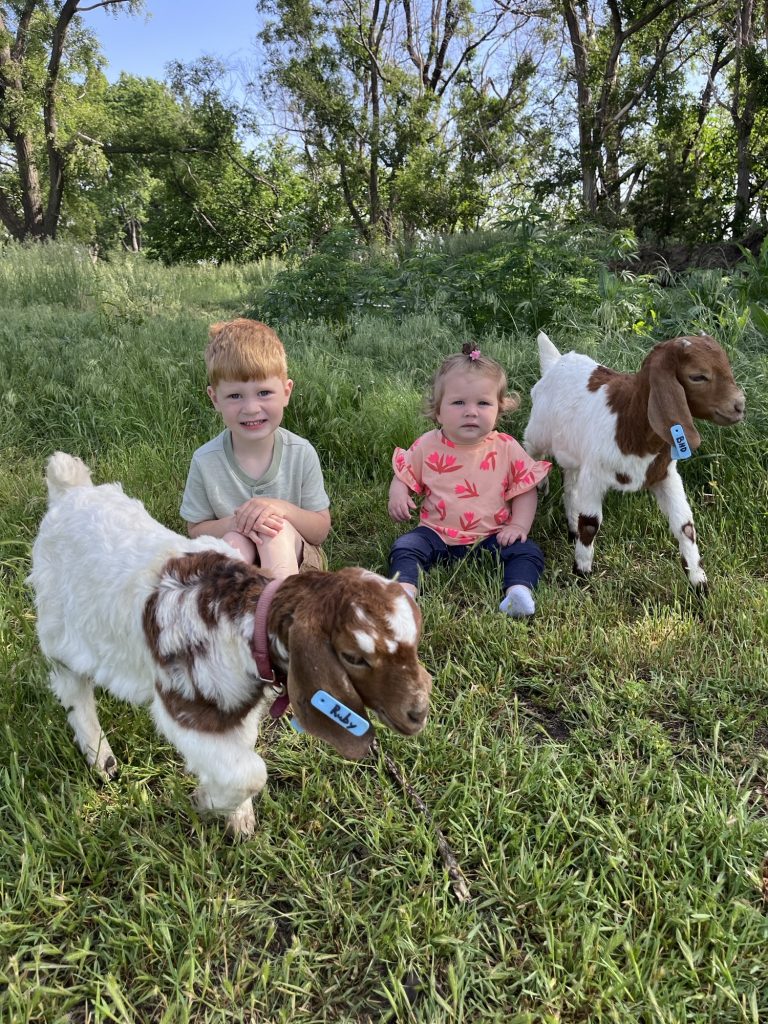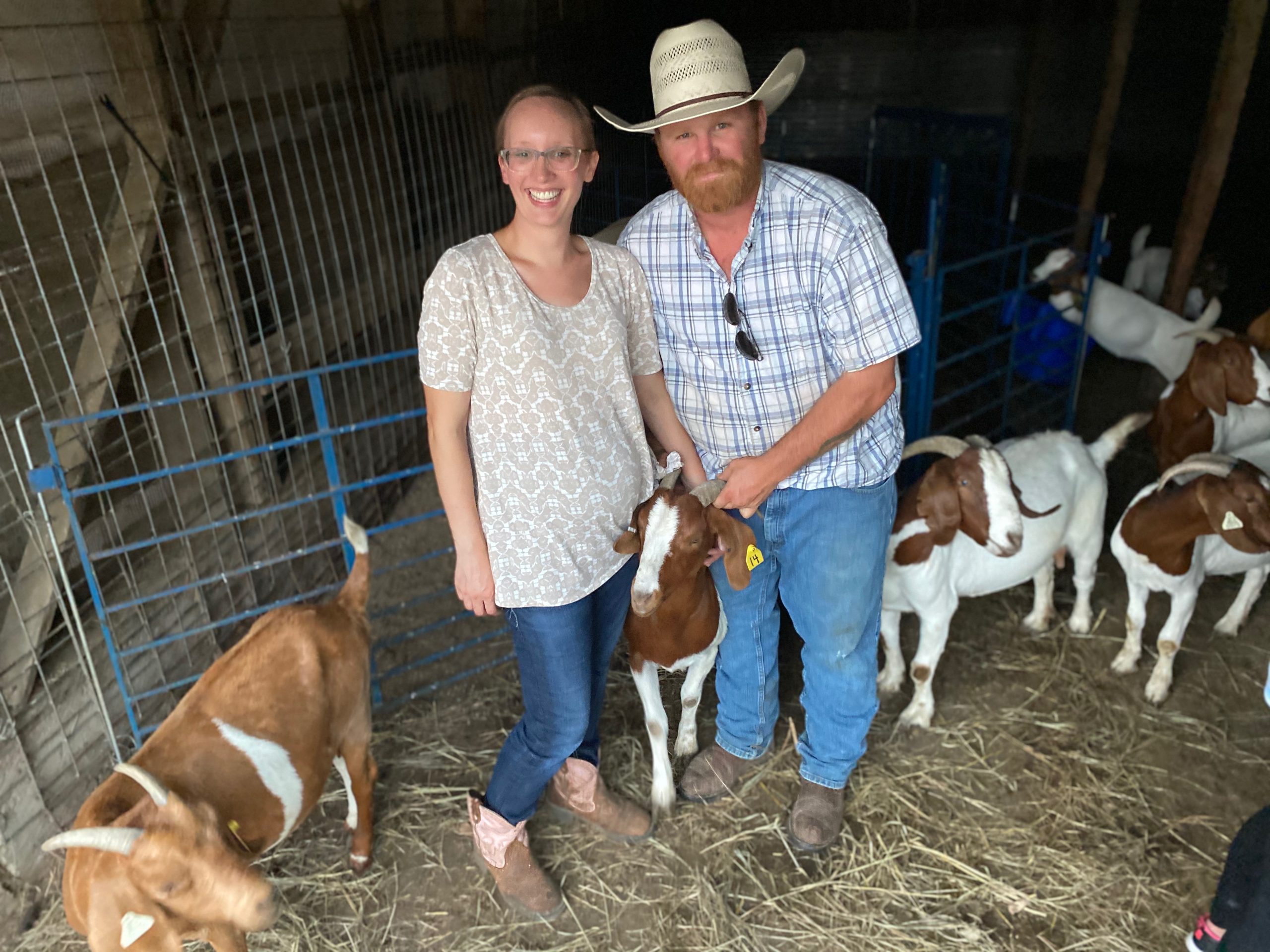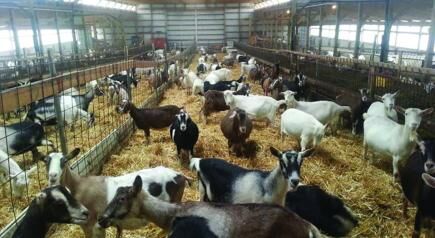On the Nebraska prairie, Josh and Karly Black’s story unfolds like a modern-day frontier saga.
But it is not one of cattle or corn, staple commodities for the Midwestern state. The Blacks have carved a path for themselves, raising nearly 200 meat goats on a small acreage of grassland.
The couple (pictured above), who grew up in Omaha, traded city life for Burchard, Nebraska, population 100, located just north of the Kansas border.
Their journey isn’t an isolated one. Joe and Jaden MeInick also have found a niche in meat goat production. The couple decided to venture into goats after purchasing a weedy plot of land near Hastings, Nebraska, three years ago. They opted for goats to clean up the property.
“There was a shed somewhere on the back of the property, and we didn’t even know where it was, the weeds were so tall,” Joe said, adding they weren’t even sure where the fence lines were located.
Both families have developed supplemental incomes in the meat goat market-–often breeding their herd for delivery around ethnic holidays.
Goat production increasing for small-scale farmers
Their stories are an example of the growing attraction of small-scale goat production. According to a new report from Texas AgriLife Extension Service, small goat producers are growing across the agricultural landscape, even in traditionally cattle-and-corn dominant regions like Nebraska.
That has been a consistent trend for more than a decade as more immigrants migrate to the United States from countries where goat meat is the No. 1 protein.
Randy Sander, an Extension educator with Nebraska Extension, said goats are a way for people to get started without the expense of larger livestock. It also helps families add the next generation into the operation.
“They don’t have to borrow money or worry about interest rates,” Sander said. “It adds income for a family operation, increasing that income so it can support more people. It also supports the small farmer with a little bit of land, adding that supplemental income.”
From city sidewalks to dirt roads
Josh and Karly Black didn’t have much experience in agriculture when they decided to start breeding goats. After six years in the military, Josh wanted to own his own outfitting business, while Karly, who has a master’s degree in youth and family studies, found work in Salt Lake City with the Army Reserve.
“We enjoyed the closeness of the military community where people take care of each other,” she said. “That’s what drew us to a rural community.”
Karly took a job as a Nebraska 4-H Extension agent, while Josh pursued a wildlife management degree. During his studies, Josh connected with Scott Bodie of Big Blue Ranch, who was an expert in rotational grazing cattle and eco-tourism. The two bonded over their shared love of the outdoors and their military backgrounds.
Bodie called a year later, offering Josh a crash course in ranching. “If you want 10 years of experience with animals, I’ll give it to you in one year,” Bodie told him.
“That’s what I cut my teeth on,” Josh said of calving out 565 cows for Bodie. “He said he could hire me full time, and that’s what got me on the ranching side of things.”
Josh became Bodie’s right-hand man, managing the cow herd. The Blacks eventually moved onto the ranch, which sparked a new-found interest in raising their own livestock.
They drove to Oklahoma and bought 33 meat goats.
“The goat market was a niche market that was growing,” Josh said. “For the cost to feed one cow, we could feed nine goats. They don’t take up much room. You don’t need expensive equipment.”
The Blacks learned a lot in the first year. They lost half their herd due to barber pole worms–a common goat health issue. Some beginning producers might have thrown in the towel, Karly said. Instead, they did research, connected with a good veterinarian and learned more about goat health.
Their experience yielded valuable lessons:
- Patience is paramount. Unlike the military’s fast-paced environment, raising goats demands a measured approach.
- Seek guidance. Don’t be afraid to leverage the knowledge of experienced professionals.
- Prioritize genetics.
“We now prioritize purchasing good, solid commercial does with strong maternal instincts,” Karly said.
Karly said one thing she loves is they can work together as a family with their 3-year-old, Theodore.
Josh said he also enjoys learning and working to improve the operation.
“I love being outdoors,” he said. “I love working with the animals. Every day is different. Every sunset is different.
“We’ve learned a lot, and we are still learning.”
Amy Bickel can be reached at [email protected].
Goats for a small acreage
By Amy Bickel

Joe and Jaden MeInick started with six dairy goats in 2021 for weed control.
The dairy goat market wasn’t great, Joe said. The MeInicks added meat goats a year later to supplement their dairy goat hobby. Today, they have 25 meat goats, plus dairy goats on their roughly 5 acres of property. A late May storm with straight-line winds decreased their herd by 10.
The goats helped the couple find the fence line and the shed.
“Goats were a less expensive investment to take care of the weeds,” Jaden said.
Goats are also cost-effective because they consume less food and require less acreage than cattle, Joe said.

Goats supplement their income, Jaden said. The couple both grew up on farms and work in the ag industry—Jaden for a hog genetics company and Joe for a seed company managing 35 employees. Both are involved in their county Farm Bureau. Jaden also makes goat soap, selling products to local markets.
They are mentors to others getting into the business. They offered a few tips, also.
- Know your market. The MeInicks kid twice a year, basing their breeding calendar on ethnic holidays such as Ramadan in March, Jaden said. They have found markets on Facebook and sale barns in Kansas and Nebraska.
- Genetics is key to maximizing income. Their culling process is strict. They don’t keep goats that don’t fit the genetic traits they strive for. That includes kidding ease and multiple births.
“Joe and I have both worked in the pig world and understand this from a large production standpoint,” she said. “Our goats have to meet X, Y and Z.”

While goats provide some extra income, it’s also a lifestyle and a way to teach life lessons to their children, 3-year-old Jedidiah and 1-year-old Jensyn.
“The best part is our children, Jaden said. “When Joe and I got married, we both grew up on a farm, and it’s something we wanted our kids to be part of,” Jaden said.
To learn more about both Nebraska meat goat producers, visit their Facebook pages at
MeInick Family Farms: www.facebook.com/profile.php?id=100092368016398.
Black Family Livestock: https://www.facebook.com/BlackFamilyLivestock/.




